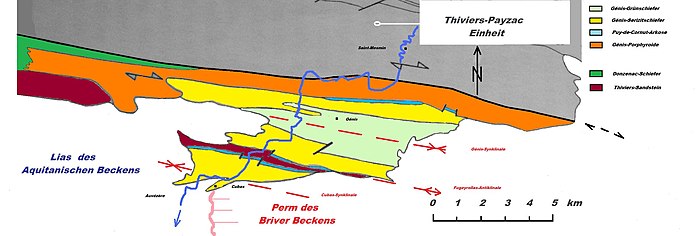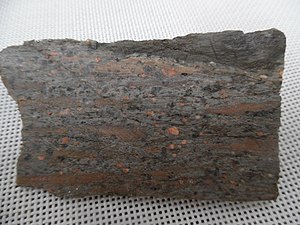Génis porphyroid
The Génis porphyroids are a low metamorphic geological formation from the Cambrian / Ordovician of the French Massif Central . The formation is of volcanic origin and forms the lying of génis unit .
Geography and geology
The Génis porphyroids are only exposed as the north limb of the Génis syncline . Here they are discordant above the Donzenac slates of the Thiviers-Payzac unit . Further south they even reach down to the Thiviers sandstone from the same unit. Your Südschenkel wedges before reaching the Fougeyrollas anticline from or is at Preyssac-d'Excideuil of Liassedimenten of the Aquitaine basin covered. The northern limit of the Génis porphyroids forms the South Limousin Fault - a significant dextral lateral shift that cuts off the Metaignimbrite from the Thiviers-Payzac unit. The northern limb follows the fault over a good 20 kilometers from Clermont-d'Excideuil to west of Juillac , where it dips under the carbonic sediments and red sediments of the Briver basin . Its streak width is between 700 meters in the west and 1500 meters on the eastern edge. The strike direction is east-southeast (N 110) with a steep dip (by 80 °) to north-northeast.
The Puy-de-Cornut-Arkose , which is stratigraphically higher, follows the Génis porphyroids with a clear angular discordance.
North-east of Preyssac-d'Excideuil, the north leg is covered over 500 meters by continental quartz rubble , which can be assigned a Miocene age .
Petrology
The Génis porphyroids, French Porphyroïdes de Génis , are former alkaline ignimbrites with a rhyolite composition. The phenocrystals contain quartz , alkali feldspar and plagioclase ( albite ) in a very fine-grained, schisty matrix (5 μm) made of quartz, feldspar , muscovite (sericite) and the rare chlorite . Original flames can hardly be seen anymore, but welded glassy layers can still be identified as such.
Their internal stratigraphy is as follows (from hanging wall to lying ):
- pink porphyroid
- Tuffs
- gray porphyroid
The two porphyry facies differ not only in their coloring, but also in their content of flame, which only really appears in the pink porphyroids . Their red coloring is caused by pink feldspars, whereby the very fine-grained matrix can be colored beige or light green in addition to pink. As a phenocrystal, quartz is usually rounded or truncated, only rarely angular and often with corrugated beeches. The alkali feldspars show irregular prisms, the angles of which can also be truncated. The flames are twisted, thickened in places or completely pinched off and often have characteristic axiolithic edges .
The gray porphyroids are quite dark rocks with a light to black-gray matrix. They have far fewer phenocrystals, which are also much smaller. Instead of flame, they have inclusions of greenish slate. Prismatic plagioclase crystals come to the fore. Their composition is An 05 and they are idiomorphic, rectangular and infiltrated by sericite.
The separating tuffs are fine-grained, yellowish rocks, the sericite-bearing matrix content of which is quite high. Small grains of quartz and feldspar can be seen in the matrix. The quartz grains take on different shapes - angular, sometimes peeled and only rarely idiomorphic or subidiomorphic. The feldspars - alkali feldspar and albite-rich plagioclase - are also often serialized. The tuffs form banks in the decimeter to meter range and alternate with fine-grained, silky, shiny, small quartz grains of sericite slate.
Occasionally glassy metarhyolites are enclosed as lens-like bodies in the Metaignimbrites. These are very compact, smooth, horn- like rocks without phenocrystals. Their color changes from gray to pink. They probably represent former devitrified lavas. In some places, welded, vitroclastic structures can still be seen, which had arisen from flattened broken glass that was once stacked on top of one another.
Mineralization
The Génis porphyroids have barite ducts in places .
Chemical composition
| Oxide wt.% |
Metaignimbrit 1 | Metaignimbrit 2 | Metaignimbrit 3 | Metaignimbrit 4 |
|---|---|---|---|---|
| SiO 2 | 70.40 | 73.03 | 73.92 | 77.03 |
| TiO 2 | ||||
| Al 2 O 3 | 14.53 | 14.27 | 14.74 | 15.43 |
| Fe 2 O 3 | 0.78 dead | 0.49 dead | 0.82 dead | 0.82 dead |
| FeO | ||||
| MnO | ||||
| MgO | 0.22 | 0.17 | 0.23 | 0.20 |
| CaO | 0.11 | 0.06 | 0.06 | 0.11 |
| Na 2 O | 2.70 | 1.77 | 2.43 | 1.18 |
| K 2 O | 7.82 | 8.74 | 4.76 | 5.84 |
| P 2 O 5 | ||||
| H 2 O - | ||||
| H 2 O + |
The metaignimbrites are clearly potassium-accentuated (two to four times more K 2 O than Na 2 O) and they contain more than 70% SiO 2 . Their chemical composition is generally alkaline and rhyolite . Their total iron content and their concentration of MgO and CaO are very low. In terms of their chemistry, they resemble rhyolites of the tremadocium from the Armorican massif .
tectonics
As already mentioned, the Génis porphyroids form part of the northern limb of the Génis Syncline, which is around 2 kilometers wide. They are intensely folded within the formation . The folds are narrow and upright and have a wavelength of about 200 meters. The fold axes , which scatter slightly around the horizontal, sweep OSE-WNW (N 110), but in the bend of the syncline at Preyssac-d'Excideuil they can dip 15 to 20 degrees to OSE. The strata surfaces (S 0 ) mostly show a very steep dip (by 80 °) to the north or south. A foliation , recognizable by newly formed minerals, has formed parallel to the fold axis planes (S 1 ). Stretch linear are also available, their direction varies between east-southeast and southeast. The foliation forms an only slightly oblique angle with the stratification, easily recognizable in the western end of the syncline.
The fold structure can be interpreted as a system of tensile folds that arose in a ductile, right-shifting, east-southeast trending shear zone . Brittle transverse breaks are short, quite rare, and strike north to northeast. Even in the brittle area, the rocks were thus subject to an east or south-east stretching.
metamorphosis
The Génis porphyroids were epizonally metamorphosed in the course of the Variscan orogenesis and are now present in the green slate facies . It is a retromorphism , recognizable by the appearance of chlorite.
Age
The Génis porphyroids have not yet been absolutely dated. Due to their petrological affinity to rhyolites of the Armorican massif (central Vendée ) and to a very similar series in the Rouergue , they were assigned an End Cambrian to Lower Ordovician deposit age (Tremadocium - 490 to 480 million years).
The retromorphosis and the right-hand shear movements are shifted to the Tournaisium / Viseum border (around 346 million years). This assumed age is confirmed by the synkinematic Estivaux granite .
See also
- Génis unit
- Geology of the Massif Central
- Ignimbrite
- Puy-de-Cornut-Arkose
- Thiviers-Payzac unit
- Variscical
literature
- P. - L. Guillot et al.: Feuille Juillac . In: Carte géologique de la France at 1/50 000 . BRGM.
- JM Peterlongo: Massif Central . In: Guides Géologiques Régionaux . Masson, 1978, ISBN 2-225-49753-2 .
- J. - Y. Roig, M. Faure and P. Ledru: Polyphase wrench tectonics in the southern Massif Central: kinematic inferences from pre- and syntectonic granitoids . In: Geologische Rundschau . tape 85 , 1996, pp. 138-153 .
- M. Roques: Les schistes cristallins de la partie Sud-Ouest du Massif Central français . In: Mem. Serv. Carte Géol. Paris 1941, p. 1-527 .
Individual evidence
- ^ R. Wyns: Contribution à l'étude du Haut Bocage vendéen: le Précambrien et le Paléozoque de la région de Chantonnay (Vendée) (doctoral thesis) . Thèse Univ. Paris VI, 1980, p. 135 .
- ↑ P. Collomb: Etude géologique du Rouergue cristallin . In: Mem. Serv. Carte Gol. 1970, p. 419 .
- ^ M. Faure and J. Pons: Crustal thinning recorded by the shape of the Namurian-Westphalian leucogranite in the Variscan belt of the Northwest Massif Central, France . In: Geology . tape 19 , 1991, p. 730-733 .



